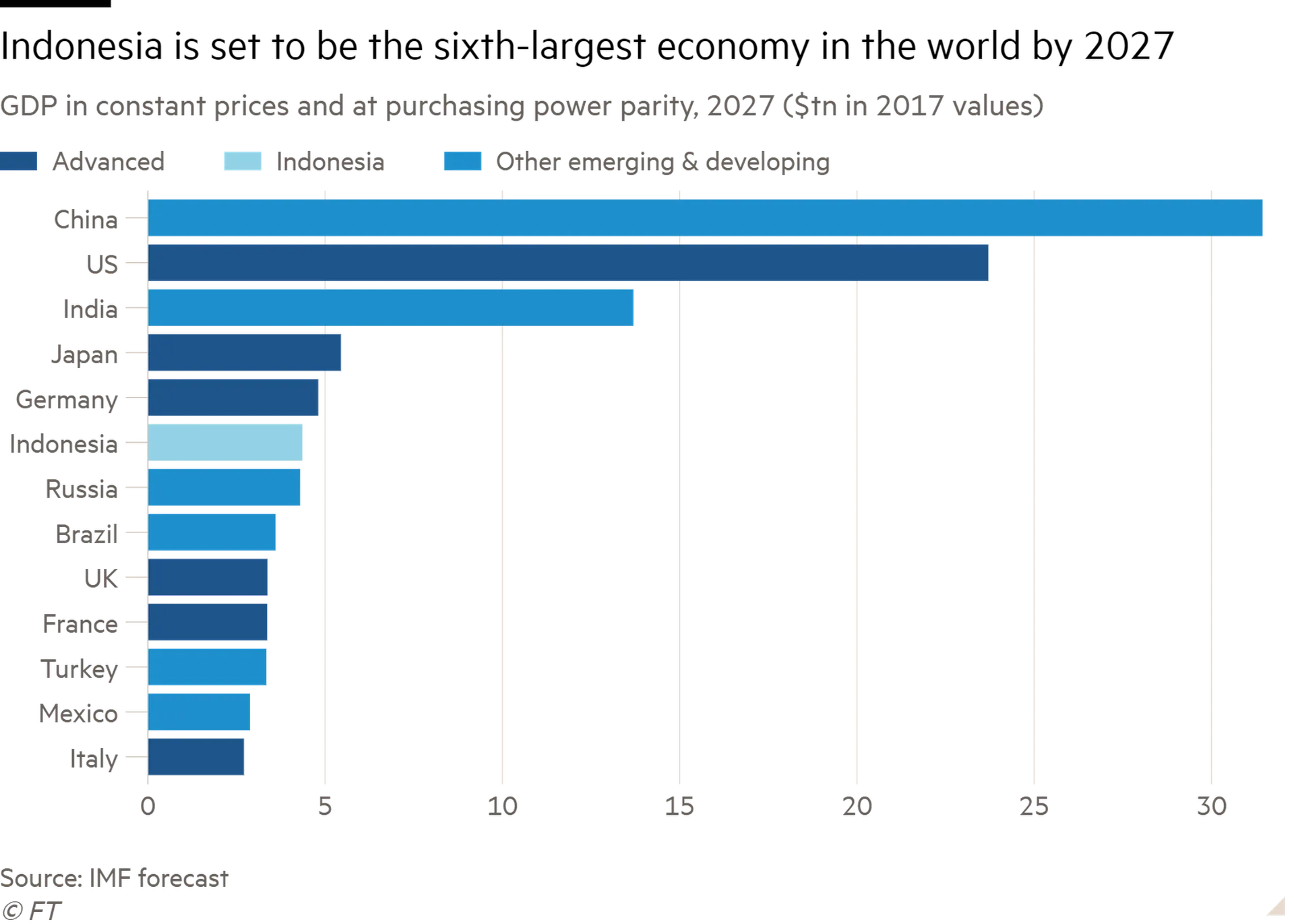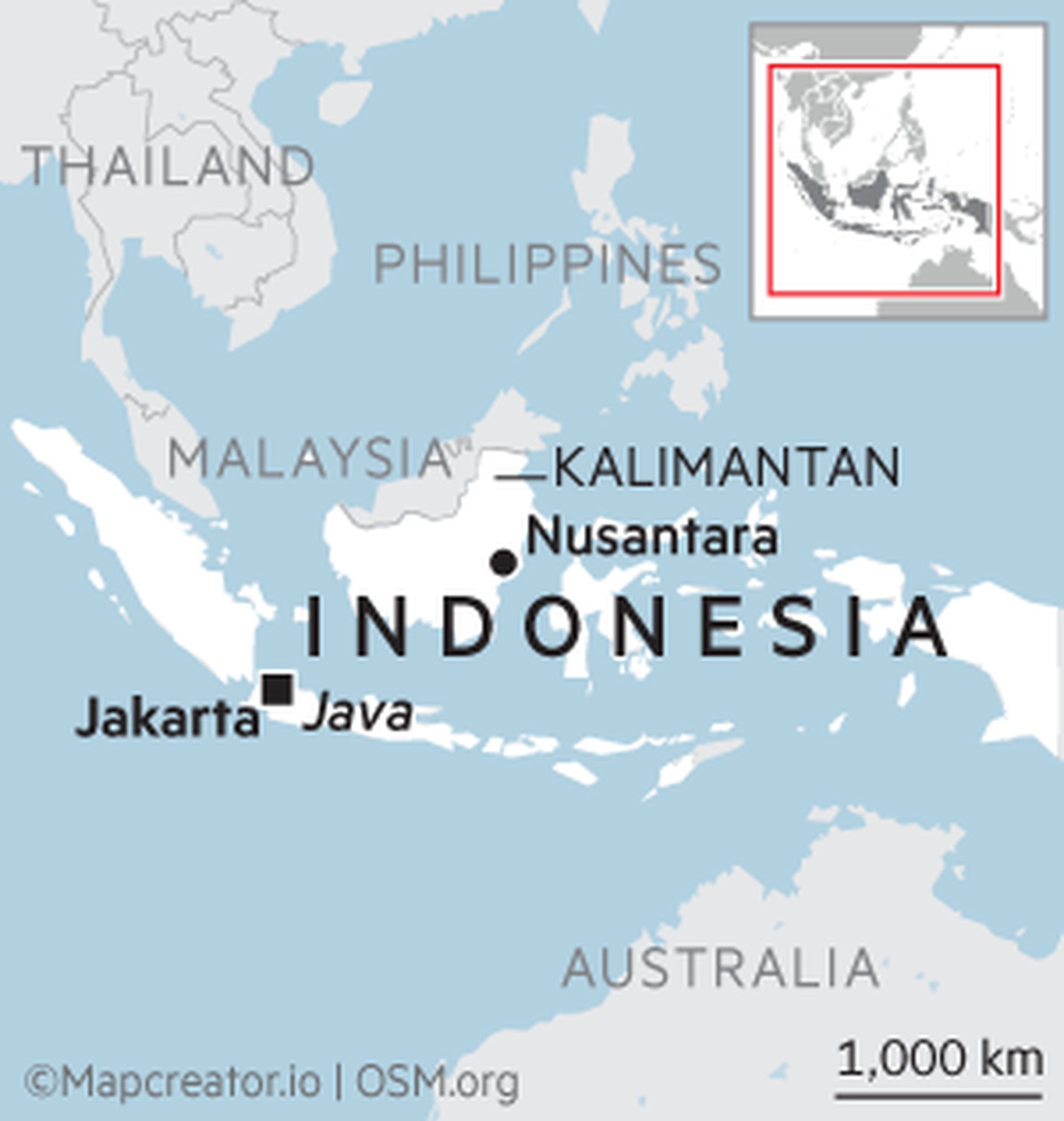尊敬的用戶您好,這是來自FT中文網的溫馨提示:如您對更多FT中文網的內容感興趣,請在蘋果應用商店或谷歌應用市場搜尋「FT中文網」,下載FT中文網的官方應用。
With the world’s fourth largest population, a flourishing middle class, a digitalising economy and five of the seven critical minerals for making electric batteries, Indonesia has long been considered a sleeping giant of great potential.
印尼擁有世界第四大人口、蓬勃發展的中產階級、數位化的經濟和製造電池所需的七種關鍵礦產中的五種,長期以來一直被認爲是一個潛力巨大的沉睡巨人。
At a conference held by UOB Asset Management in March, Colin Ng, head of Asia equities for the financial services group, called Indonesia, a “sitting jackpot”. “When you invest in Indonesia, you are basically investing in the future,” he said.
在大華銀行資產管理公司(UOB Asset Management)今年3月舉行的一次會議上,這家金融服務集團的亞洲股票主管Colin Ng稱印尼是一個「可坐等的頭獎。當你在印尼投資時,你基本上是在投資未來,」他說。
For Indonesia’s economy — the largest in south-east Asia — the global shift to producing electric vehicles has provided a strong tailwind. The country has abundant reserves of nickel — a key mineral for creating batteries — and is aiming to become a hub for the new energy supply chain.
對於東南亞最大的經濟體印尼來說,全球轉向生產電動汽車提供了強勁的推動力。該國擁有豐富的鎳儲量——一種製造電池的關鍵礦物——並正致力於成爲新能源供應鏈的中心。

Investor interest has followed that of the major carmakers. The number of investors in Indonesia’s capital markets has grown from 1.1mn at the end of 2017 to almost 12mn at the end of October 2023, according to Trimegah Asset Management, a major asset management business in Indonesia — a 10-fold increase in just six years.
投資者的興趣緊隨主要汽車製造商之後。根據印尼主要資產管理公司Trimegah Asset Management的數據,印尼資本市場的投資者數量已從2017年底的110萬成長到2023年10月底的近1200萬,在短短六年內成長了10倍。
“The majority of growth [was] driven by the availability of digital financial platforms that made it easy for people, especially the younger generation, to invest,” explains Antony Dirga, chief executive at Trimegah.
Trimegah首席執行長安東尼•迪爾加(Antony Dirga)解釋說:「大部分成長是由數字金融平臺的便捷性推動的,這些平臺使人們(尤其是年輕一代)更容易進行投資。」
When you invest in Indonesia, you are basically investing in the future
當你在印尼投資時,你基本上是在投資未來
Among these investors are wealthy individuals from around the world, who have opened banking facilities in the country. According to government data, as of the quarter ended September 2023, total deposits in Indonesia had reached 8,203tn rupiah ($529bn) — a 35 per cent increase from the end of 2019. And the number of accounts increased by 77 per cent, from 301mn accounts to 535mn.
這些投資者中有來自世界各地的富豪,他們在印尼開設了金融賬戶。根據政府數據,截至2023年9月底的一個季度,印尼的存款總額達到82.03億印尼盾(約合5290億美元),比2019年底成長了35%。賬戶數量增加了 77%,從 3.01 億個賬戶增加到 5.35 億個。
Vera Margaret, executive director and head of deposit and wealth management at UOB Indonesia says the number of customer information files — electronic records of bank customers — has grown fourfold in the past three years, after it launched digital banking in the country.
印尼大華銀行(UOB Indonesia)執行董事兼存款和財富管理主管維拉•瑪格麗特(Vera Margaret)表示,自大華銀行在印尼推出數字銀行業務以來,客戶資訊檔案(銀行客戶的電子記錄)的數量在過去3年裏成長了4倍。
But she believes Indonesia must do more if it wants to lure more wealthy individual clients away from global family offices or big private banks in Hong Kong or Singapore. That will mean offering a greater variety of financial products, as well as making such services more accessible to middle-income clients, Margaret says.
但她認爲,如果印尼想從全球家族理財室或香港或新加坡的大型私人銀行吸引更多富有的個人客戶,就必須做得更多。瑪格麗特說,這將意味著提供更多樣化的金融產品,並使中等收入客戶更容易獲得此類服務。
So far, fund inflows have been disappointing. Although wealth managers and supply chain executives agree on the potential of Indonesia, the country of 277mn people has struggled to translate that interest into broader, international investment.
迄今爲止,基金流入情況令人失望。儘管財富管理公司和供應鏈高階主管都認同印尼的潛力,但這個擁有2.77億人口的國家一直難以將這種興趣轉化爲更廣泛的國際投資。

The local fund management industry had 508.19tn rupiah ($32.5bn) of assets under management (AUM) at the end of 2022, a 12.4 per cent decline from 579.93tn rupiah ($37.1bn) in 2021, according to figures from the Financial Services Authority of Indonesia. In addition, AUM stood at about 4 per cent of GDP, compared with 25 to 30 per cent in Malaysia and Thailand.
根據印尼金融服務管理局(Financial Services Authority of Indonesia)的數據,截至2022年底,當地基金管理業管理的資產(AUM)爲508.19兆印尼盾(合325億美元),較2021年的579.93兆印尼盾(合371億美元)下降12.4%。此外,該國的資產管理規模約爲GDP的4%,而馬來西亞和泰國的這一比例爲25%至30%。
“The tax and administrative situation here is not at all conducive to the establishment of domestic family offices and wealth management infrastructure,” argues Eugene Galbraith, director at mobile phone tower company PT Protelindo, and a longtime observer of Indonesian business. However, the more mass affluent, that is to say high end-focused wealth management businesses have seen “some growth”, he adds.
「這裏的稅收和行政狀況根本不利於建立國內家族辦公室和財富管理基礎設施,」手機信號塔公司PT Protelindo董事尤金•加爾佈雷斯(Eugene Galbraith)表示。加爾佈雷斯長期觀察印尼商業。不過,他補充稱,更富的大衆財富管理業務(即專注於高階的財富管理業務)出現了「一些成長」。
Some of the problems holding back Indonesia’s manufacturing sector help to explain the difficulties wealth managers find
阻礙印尼製造業發展的一些問題,有助於解釋財富管理機構所遇到的困難
“Indonesia has been fantastic at attracting investment in tech start-ups, for example, thanks to its large domestic market,” says Steven Westervelt, Singapore head of global investigations firm Nardello & Co. “There are many businesses filling and creating the needs of Indonesian people. But, in terms of making products and selling them to the global market from the US to Europe, they have not been as successful.”
全球調查公司Nardello & Co.的新加坡主管史蒂文•韋斯特維爾特(Steven Westervelt)表示:「例如,由於其龐大的國內市場,印尼在吸引科技新創企業投資方面一直表現出色。有許多企業滿足並創造了印尼人民的需求。」但是,在製造產品並將其銷售到從美國到歐洲的全球市場方面,他們就不那麼成功了。」
High costs, unclear tax regulations and opaque bureaucracy have dogged Indonesia’s attempts to persuade more multinationals to build domestic factories and provide a broad boost to its economy, beyond its mining sector, experts say.
專家們表示,高昂的成本、不明確的稅收法規和不透明的官僚作風,一直困擾著印尼政府說服更多跨國公司在國內建廠,並在採礦業之外爲該國經濟提供廣泛提振的努力。
High tech companies such as Apple, Sony and Samsung have picked neighbouring countries over Indonesia to expand in, and to manufacture their goods, as they diversify away from China.
蘋果(Apple)、索尼(Sony)和三星(Samsung)等高科技公司在將供應鏈部分搬離中國的過程中,選擇了印尼的鄰國而不是印尼來擴張和生產它們的產品。
22%Corporate tax rate in Indonesia
22%
Indonesia has not been able to compete effectively. At 22 per cent, its corporate tax rate is not much higher than Vietnam’s 20 per cent, notes Thomas Hansmann, head of operations practice for south-east Asia, at consultants McKinsey & Company. “But Vietnam offers tax breaks and incentives like tax free periods,” points out Hansmann. As a result, a company like Samsung, in effect, pays about 5 per cent in tax in Vietnam.
22%印度尼西亞的企業稅率
Even Indonesia’s individual taxes can be difficult to navigate — a factor that many high net worth individuals and wealthy investors take into account, says Galbraith.
印尼一直無法有效競爭。諮詢公司麥肯錫(McKinsey & Company)東南亞業務實踐主管托馬斯•漢斯曼(Thomas Hansmann)指出,印尼22%的企業稅率並不比越南的20%高多少。「但越南提供稅收減免和免稅期等激勵措施,」漢斯曼指出。因此,像三星這樣的公司實際上在越南只繳納約5%的稅。
Logistics and skilled labour are the other economic hurdles. Despite huge investment by the Joko Widodo government in upgrading ports, toll roads, airports and other infrastructure, logistics costs remain high.
加爾佈雷斯說,就連印尼的個人稅收也很難把握,這是許多高淨值個人和富有投資者考慮的一個因素。
“Logistics costs in Indonesia as a percentage of GDP are 26 per cent,” calculates Vivek Luthra, a managing director specialising in supply chain and operations at Accenture. “Most other south-east Asian countries are around 15 per cent.”
物流和熟練勞動力是其他經濟障礙。儘管佐科•維多多政府投入巨資升級港口、收費公路、機場和其他基礎設施,但物流成本仍然很高。

埃森哲(Accenture)專門負責供應鏈和運營的董事總經理維韋克•盧瑟拉(Vivek Luthra)估計:「印尼的物流成本佔GDP的比例爲26%。其他大多數東南亞國家的比例在15%左右。」
Qualified staff can be hard to find, too. Much of Indonesia’s large labour force lacks the skills that international corporations need. There is an “education gap” compared with countries such as Vietnam and Malaysia, says Westervelt, which is why so many high-tech companies have gone elsewhere.

Such entrenched problems have held back the development of the financial services sector in Indonesia’s economy — such as capital markets and wealth management — experts conclude.
合格的員工也很難找到。印尼龐大的勞動力隊伍中,很多人缺乏跨國公司所需的技能。維斯特維爾特說,與越南和馬來西亞等國相比,印尼存在著「教育差距」,這也是爲什麼如此多的高科技公司選擇到其他國家發展的原因。
But improvements in per capita income offer some hope. The World Bank estimated that Indonesia’s gross national income (GNI) per capita was $4,580 in 2022 — higher than India but lower than Malaysia or Thailand. Cleaning up Indonesia’s economy and becoming more attractive to foreign groups could help lift the country out of this so termed middle-income trap in which it has been stuck for years.
專家們總結說,這些根深蒂固的問題阻礙了印尼經濟中金融服務部門(如資本市場和財富管理)的發展。
“When the country’s GDP per capita exceeds $5,000, people tend to have excess savings available for investments after paying for basic necessities such as food, clothings, mortgages and auto loans,” explains Dirga.
但人均收入的提高帶來了一些希望。世界銀行估計,到2022年,印度尼西亞的人均國民總收入(GNI)爲4580美元,高於印度,但低於馬來西亞或泰國。整頓印尼經濟,提高對外國集團的吸引力,可能有助於該國擺脫多年來一直陷入的所謂中等收入陷阱。
This year, Indonesia’s GDP per capita is predicted to finally reach $5,000 — which Dirga thinks could give the wealth management industry the potential to reach $150bn to $200bn AUM within the five to seven years.
「當一個國家的人均GDP超過5000美元時,人們在支付了食品、衣服、抵押貸款和汽車貸款等基本必需品後,往往有多餘的儲蓄可用於投資,」迪爾加解釋說。
“[This is] still small in a global context, but Indonesia will probably be among the few countries whose wealth management sector will achieve high double-digit growth in the coming years,” he predicts.
今年,印尼的人均GDP預計將最終達到5000美元——迪爾加認爲,這可能使財富管理行業在未來5至7年內達到1500億至2000億美元的資產管理規模。
他預測:「在全球範圍內,(這一比例)仍然很小,但未來幾年,印尼很可能成爲財富管理行業實現兩位數高速成長的少數幾個國家之一。」